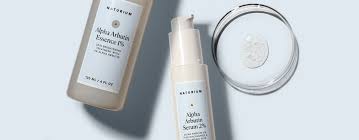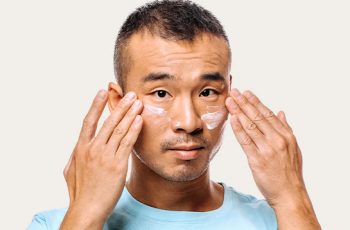
Alpha Arbutin and Beta Arbutin in Skin Care Products
The two types of arbutin, alpha arbutin and beta arbutin, are cosmeceutical ingredients in skin care products that are tyrosinase inhibitors used to treat hyperpigmentation. Arbutin serums and arbutin creams are popular skin care products used to lighten dark spots on the skin, especially when using hydroquinone is undesirable. Compounding pharmacies may make a skin lightening product that has hydroquinone and arbutin together, but you will no longer see hydroquinone available without a prescription.
Arbutin is one of the most commonly used skin care ingredients to lighten skin that is available over the counter without a prescription.
Alpha Arbutin vs Beta Arbutin
There are two forms of arbutin found in skincare. They have the same chemical structure but different rotational configurations which gives them slightly different effects on melanin production.
Alpha arbutin (4-hydroxyphenyl alpha-glucopyranoside)-
Does not occur naturally so will not be found in natural or organic skin care products
Is synthetic
Is a stronger tyrosinase blocker than the beta arbutin form
Studies have demonstrated that synthetic α-arbutin is 10 times more effective than natural arbutin.[6]
Beta arbutin (4-hydroxyphenyl beta-glucopyranoside)-
Occurs naturally in plants.
Found in the dry leaves of bearberry, cranberry, blueberry, wheat, and other plants.[1],[2]
This is the form used in natural and organic skin care creams and serum.
berries
Arbutin is primarily used for depigmenting, or skin lightening, but also can serve as a protective agent against the sun.
Arbutin vs Hydroquinone
Arbutin is structurally very similar to hydroquinone
Arbutin is hydroquinone bound to a sugar molecule
Both hydroquinone and both forms of arbutin block tyrosinase activity which leads to less production of skin pigment.
If you are allergic to hydroquinone, you may also be allergic to arbutin but it is less likely
Arbutin has less melanocytotoxicity than hydroquinone and less skin irritation.
Arbutin does not cause ochronosis like hydroquinone can
Arbutin Benefits:
Arbutin has antioxidant, anti-inflammatory, and skin lightening properties.[3],[4] While naturally occurring beta arbutin has garnered attention in the cosmetic and therapeutic realms as an alternative to HQ, evidence suggests that a synthetic version of the botanical agent called alpha arbutin is even more effective.
Anti-inflammatory
Antioxidant
Skin Lightening
What is Arbutin Used For:
Its anti-inflammatory, antioxidant, and, in particular, anti-tyrosinase properties make it useful in skincare regimens designed to lighten skin. This is because inflammation can lead to hyperpigmentation so soothing the skin helps prevent dark spots on the skin.
Both forms of arbutin are used to treat hyperpigmentation skin problems such as:
Melasma
Postinflammatory hyperpigmentation (PIH)
Safety
Arbutin is thought to be a safe alternative to HQ according to the US FDA. It is allowed in cosmetic products while hydroquinone is not. However, it has been banned for safety reasons in European Union, Japan, Australia, and some African countries due to its similarity in chemical structure to hydroquinone. If you have an allergy to hydroquinone, you should avoid arbutin.
Side effects of arbutin include stinging and allergic dermatitis. The Environmental Working Group (EWG) gives arbutin a 1 rating (safe).
Pregnancy
Arbutin is a glycosylated hydroquinone derivative. Unlike hydroquinone, which is a potent depigmenting agent with higher risks, arbutin releases hydroquinone slowly and in much smaller amounts, reducing potential toxicity. When applied topically, arbutin has low systemic absorption, meaning it does not significantly enter the bloodstream and therefore poses minimal risk to the fetus. There are no known studies indicating teratogenic (birth defect-causing) effects of arbutin when used topically. Its safety profile is generally considered acceptable, especially in comparison to other more aggressive skin-lightening agents.
Arbutin is recommended for the following Baumann Skin Types:
DRPT, DRPW, DSPT, DSPW, ORPT, ORPW, OSPT, OSPW
undefined
The Best Skin Care Products with alpha Arbutin and beta Arbutin
Although it is much better to shop by your Baumann Skin Type, you can find the best arbutin serums and creams here.
Find the best products with arbutin such as Arbutin serums and creams
Where does α-arbutin or β-arbutin come from?
The source of arbutin in skin care differs. Alpha arbutin is made in the laboratory. Beta arbutin is primarily extracted from the bearberry plant (Arctostaphylos uva-ursi) but is also found in blueberry, cranberry, wheat, and other plants. Other arbutin derivatives, such as deoxyarbutin, are synthesized by chemical and enzymatic methods.[5]
hydroquinone and arbutin
Chemistry of Arbutin in Skin Care Products:
Arbutin is structurally very similar to hydroquinone. They both have benzene rings.
Arbutin is hydroquinone bound to a sugar molecule
Arbutin is either one of these:
α–D glucopyranoside
β-D glucopyranoside
Environmental Impact of Arbutin in Skin Care
It is not well established what impact the cultivation of arbutin sources has on the environment. Similarly, it is not yet known how the culling of plants containing arbutin for the processing of synthetic forms of the ingredient affects the environment. There are no known environmental concerns.
Product Formulation Considerations
Skin penetration is an issue with many ingredients including arbutin. Various methods have been used to enhance skin penetration.[7]
Arbutin in Skin Care Routines: Regimen Design Considerations
The hydrophilic nature of arbutin limits penetration into human skin. Arbutin should be used with penetration enhancing ingredients when possible such as hyaluronic acid and oleic acid. When designing a skin care routine, care should be taken to design the order of steps in the routine to increase absorption of arbutin. Saturated fatty acids in moisturizers may decrease effectiveness of arbutin, so look for moisturizers with unsaturated fatty acids like linoleic acid.
Evidence- Based Research
Several clinical studies have indicated that arbutin used in combination with another depigmenting agent or therapy to treat melasma or other skin hyperpigmentation conditions is as effective as monotherapy while less likely to induce side effects.[8]
In other words: arbutin works bets when combined with other skin lightening and whitening ingredients.
Bottom Line on Arbutin in Skin Care
Used traditionally in Japan, arbutin is one of the best skin whitening ingredients in the Unites States. It is less effective than hydroquinone but safer than HQ. Synthetic versions of arbutin compare with HQ in effectiveness, but natural arbutin is also effective especially when combined with other tyrosinase inhibitors. Arbutin is found in many skin care products to treat melasma, skin aging, and to protect the skin from the damage from sun exposure.
Is Arbutin right for you? You need to take the skin care quiz to find out.


